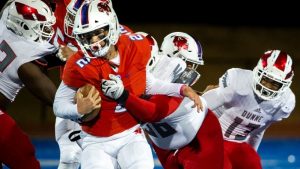In this article, we’re going to be talking about the techniques a quarterback needs in order to handle the pocket, even when things break down.
We are also going to introduce our “P3” concept and drills that will turn your quarterback into the steady hand that you need him to be when the game is on the line. These quarterback drills are not only going to help him on the field but also in life off the gridiron.
What does pressure look like?
By looking at the image, you realize how tough it is for a quarterback to keep his head in the game. This is why he should know how to deal with pressure and work the pocket.
Pocket Presence. Poise. Patience
So, let’s get into the details of P3:
1. Pocket Presence
Pocket presence is the unique ability of a quarterback to operate in the pocket.
Pocket presence is important because it helps the quarterback deal with the pressure without panicking. Pocket pressure is the ‘ice in his veins’ that he must have in order to make the right moves in tight spaces.
2. Poise
Poise, also known as awareness, is a must for every quarterback. A quarterback must keep his poise at all times without abandoning the pocket.
The quarterback needs to understand just because he sees the opposite color doesn’t mean the defender is in his face.
Many young quarterbacks give in to the pressure even before the defender comes at them. This, in turn, causes them to make poor decisions and kills their performance.
I’ve coached a few quarterbacks who couldn’t achieve long-term success because of their inability to handle defensive pressure and lack of awareness. They abandoned the pocket as soon as they got a glimpse of the opposite color coming their way.
3. Patience
Patience is the key. Patience is simply the quarterback having enough awareness to be patient when a concept is unfolding in front of him. This is triggered by the quarterback’s internal clock. We teach our quarterbacks that they have roughly 3 seconds to make a decision before taking off out of the pocket.
This clock is tested in practice during quarterback drills as well as during our practice script in team on all pass plays. I take a measure of how long it takes him to get the ball out of his hands on all Quick game and drop back concepts and that timing helps me understand whether he really understands what he’s looking at.
Keys to Handling Pressure
We’ve discussed the elements. Now, let’s get into the details of handling pressure and speak directly to quarterbacks.
1. Trust your Internal Clock
Get to know the coverages and pass movements. When you combine these two, you’ll learn how to handle the pressure according to your internal clock.
2. Don’t Make a Bad Play Worse
If pass protection is breaking down, don’t force the pass “into the blind”.
Instead, memorize these three words; ‘eat it or throw it away’. If you don’t see any possibility of throwing the ball away, take the sack for the team and live another down. Still, if you get the chance, throw the ball toward the water cooler on the sideline, far away from the defender.
3. Keep Eyes Downfield
Do you want to be effective in the game?
Pre-snap the defensive box after you’ve checked the safeties and at glanced at the DB’s leverage. Never post-snap or stare down on the defensive line rush. Just feel the pressure, but never let it consume you. Understand the difference.
4. Trust your Peripheral Vision
Learn to trust your peripheral vision.
In order to keep your eyes downfield, you have to trust your peripheral vision. It’s the difference in being a great quarterback versus a paranoid jersey holder who plays quarterback. Your peripheral vision is what gives you an edge; it lets you know what’s really around you without staring at it. Your peripheral vision allows you to feel the presence of the defense and teaches you how to make subtle movements away from the pressure while looking downfield.
Escapes and Shoulder Roll
Escapes are known as the front or back door exits from the pressure pocket.
Over 60% of your throws are made under duress and require you to reset your feet or throw on the run due to pressure. As a QB, you will have one of 4 types of escapes to either keep the play alive in the “air.”
1. A or B Gap Escape
A or B Gap Escape = Slide Away and Up into Pocket and throw away from pressure.
2. C Gap Escape
C Gap Escape = Roll to the side of pressure putting ball on back shoulder, beating defender to edge. When you get flushed out of pocket, you maintain your advantage by escaping outside of “C” gap defender and either throw or run.
3. D Gap Escape
D Gap Escape = Right-handed QB, pressure from right, shoulder roll under and outside defender in D gap to make throw. The key is QB must climb away from is previous spot to create new pocket.
P3 Footwork Drills
You can reinforce the following quarterback drills from this video:
- Keeping eyes downfield
- Using peripheral vision and trusting it
- Working the pocket with subtle movements
- Maintaining a great base
- Learn Pocket Presence, Poise, and Patience
To train a quarterback right, you need to teach him these drills. But if you really want to take your quarterback to the next level or if you are a quarterback, then you must download the Quarterback Equalizer. The Quarterback Equalizer will help train a quarterback’s eyes and internal clock, which is all part of P3.
P3 Footwork Drills
OFFENSE VS DEFENSE PRACTICE EXAMPLES
P3 Game time examples

